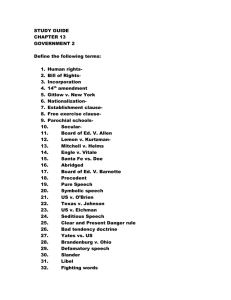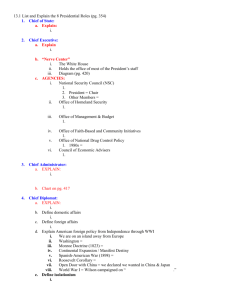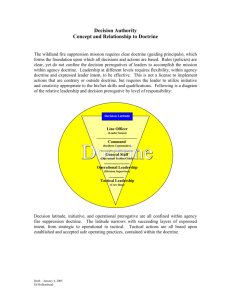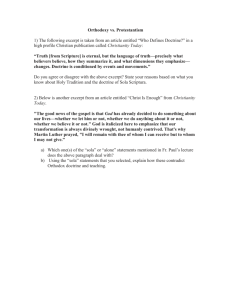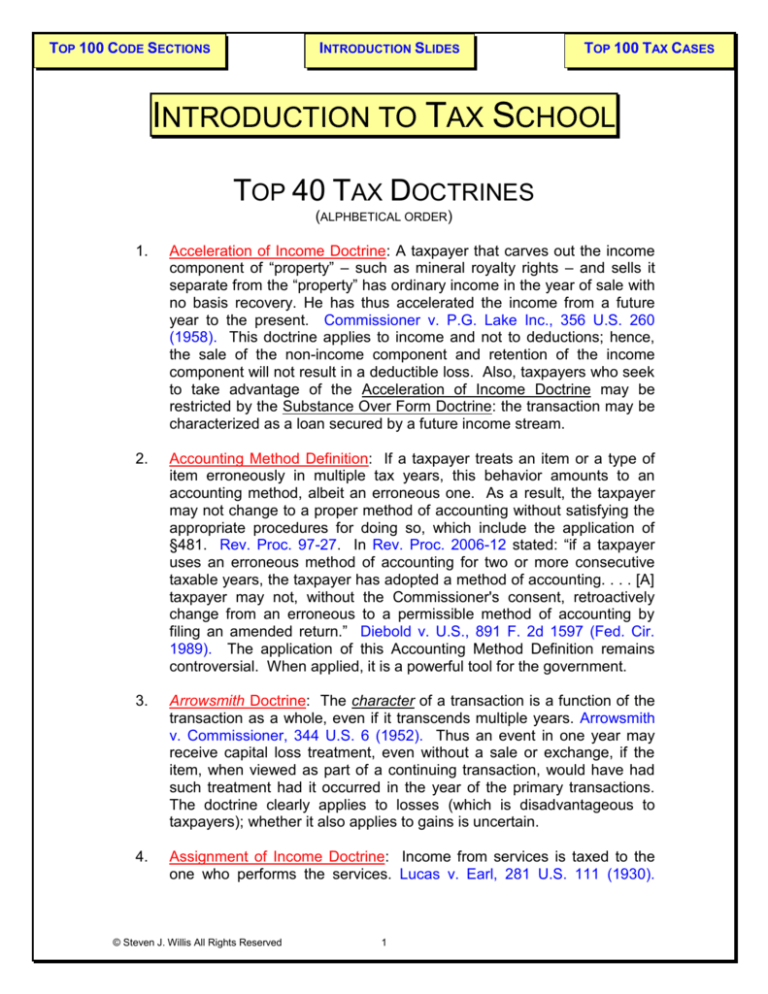
TOP 100 CODE SECTIONS
INTRODUCTION SLIDES
TOP 100 TAX CASES
INTRODUCTION TO TAX SCHOOL
TOP 40 TAX DOCTRINES
(ALPHBETICAL ORDER)
1.
Acceleration of Income Doctrine: A taxpayer that carves out the income
component of “property” – such as mineral royalty rights – and sells it
separate from the “property” has ordinary income in the year of sale with
no basis recovery. He has thus accelerated the income from a future
year to the present. Commissioner v. P.G. Lake Inc., 356 U.S. 260
(1958). This doctrine applies to income and not to deductions; hence,
the sale of the non-income component and retention of the income
component will not result in a deductible loss. Also, taxpayers who seek
to take advantage of the Acceleration of Income Doctrine may be
restricted by the Substance Over Form Doctrine: the transaction may be
characterized as a loan secured by a future income stream.
2.
Accounting Method Definition: If a taxpayer treats an item or a type of
item erroneously in multiple tax years, this behavior amounts to an
accounting method, albeit an erroneous one. As a result, the taxpayer
may not change to a proper method of accounting without satisfying the
appropriate procedures for doing so, which include the application of
§481. Rev. Proc. 97-27. In Rev. Proc. 2006-12 stated: “if a taxpayer
uses an erroneous method of accounting for two or more consecutive
taxable years, the taxpayer has adopted a method of accounting. . . . [A]
taxpayer may not, without the Commissioner's consent, retroactively
change from an erroneous to a permissible method of accounting by
filing an amended return.” Diebold v. U.S., 891 F. 2d 1597 (Fed. Cir.
1989). The application of this Accounting Method Definition remains
controversial. When applied, it is a powerful tool for the government.
3.
Arrowsmith Doctrine: The character of a transaction is a function of the
transaction as a whole, even if it transcends multiple years. Arrowsmith
v. Commissioner, 344 U.S. 6 (1952). Thus an event in one year may
receive capital loss treatment, even without a sale or exchange, if the
item, when viewed as part of a continuing transaction, would have had
such treatment had it occurred in the year of the primary transactions.
The doctrine clearly applies to losses (which is disadvantageous to
taxpayers); whether it also applies to gains is uncertain.
4.
Assignment of Income Doctrine: Income from services is taxed to the
one who performs the services. Lucas v. Earl, 281 U.S. 111 (1930).
© Steven J. Willis All Rights Reserved
1
Income from property is taxed to the owner of the property. Helvering v.
Horst, 311 U.S. 112 (1940).
5.
Burgess/Battlestein Scenario: A taxpayer may not “pay” an amount with
funds borrowed from the creditor immediately prior to the attempted
“payment.” Battlestein v. Commissioner, 631 F.2d 1182 (5th Cir. 1980)
(en banc). A taxpayer, however, may borrow funds from a third party
and then effectuate a “payment” using those funds. Economically, the
two transactions are identical. Legally, however, they are different.
Under the Burgess decision, a taxpayer may borrow from a creditor,
commingle the funds with other funds, wait some period of time (see the
Old and Cold Doctrine) and then successfully “pay” the creditor/lender.
6.
Business Purpose Doctrine: If a transaction has no Substantial Business
Purpose other than tax avoidance or reduction of income tax, the law will
not respect the transaction. This doctrine arose from Gregory v.
Helvering, 293 U.S. 465 (1935), which also addressed the Substance
Over Form Doctrine.
7.
Cash Equivalence Doctrine: An unsecured promise to pay of a solvent
obligor, readily transferable, not subject to set-off, and not subject to a
discount substantially greater than the prevailing market rate is the
equivalent of cash. Cowden v. Commissioner, 289 F.2d 20 (5th Cir.
1961). As such, the fair market value of the promise is includible in
income upon receipt by a cash method taxpayer. Under the Schlude
Doctrine, it is also likely includible in the income of an accrual method
taxpayer.
8.
Chevron Deference: The judiciary must defer to an executive agency's
interpretation of a statute that the agency administers, provided that the
agency's interpretation is reasonable. Chevron, U.S.A., Inc. v. National
Resources Defense Council, Inc., 467 U.S. 837 (1984).
9.
Commerciality Doctrine: Organizations which are overly commercial are
not entitled to exempt status under § 501(c)(3) and its predecessors.
Better Business Bureau of Washington, D.C., Inc. v. United States, 326
U.S. 279 (1945).
10. Claim of Right Doctrine: When a taxpayer receives funds (which
represent earnings) with a contingent obligation to repay, either because
the sum is disputed or mistakenly paid, and no limitation on the use of
the funds exists, those funds are included in the taxpayer’s income in the
year they are received. North American Oil Consolidated v. Burnet, 286
U.S. 417 (1932). This rule applies to cash method taxpayers. Whether
it also applies to accrual method taxpayers is an issue of the Schlude
Doctrine.
© Steven J. Willis All Rights Reserved
2
11. Cohan Rule: If the amount of an expense cannot be proved specifically
by the taxpayer, the trier of fact may nevertheless estimate a reasonable
amount. If an amount has clearly been expended, to allow nothing
because of inadequate documentation is unreasonable. Cohan v.
Commissioner, 39 F.2d 540 (2d Cir. 1930). Caution: Congress has
superseded this doctrine in many areas. For example, § 274(d)
disallows travel and entertainment expenses (the type involved in
Cohan) without adequate records corroborating the taxpayer’s
testimony. Similarly, § 170(f)(11) requires documentation for most
charitable contributions.
12. Constructive Receipt Doctrine: A cash method taxpayer has income
when the proceeds are available to him, without substantial limitations,
and he refuses or neglects to accept them. Knowledge of the availability
is generally a necessary factor, as well. This doctrine arises from Treas.
Reg. § 1.451-2(a). The Cowden v. Commissioner, 289 F.2d 20 (5th Cir.
1961) gloss holds that a taxpayer may decline to enter into a contract
which would offer current receipt; hence, a taxpayer may delay receipt
without invoking the Constructive Receipt Doctrine if he does so at the
inception of the contract. Also, under Martin v. Commissioner, 96 T.C.
814 (1991), a cash method taxpayer may sometimes modify a contract,
after partial performance, to defer receipt of payments without triggering
the Constructive Receipt Doctrine.
13. Corn Products Doctrine: The § 1221 list of non-capital assets is
illustrative rather than exclusive. Corn Products Refining Co. v.
Commissioner, 350 U.S. 46 (1955). This doctrine was effectively
eliminated by the Arkansas Best exception pursuant to which the Corn
Products Doctrine applies only to hedging transactions. Arkansas Best
Corp. v. Commissioner, 485 U.S. 212 (1988).
14. Court Holding Company Doctrine:
Under the assignment of income
doctrine, transferee completion of a transaction negotiated and fully
arranged by a transferor may be attributed to the transferor along with an
imputed transfer of the proceeds. Commissioner v. Court Holding Co.,
324 U.S. 331 (1945). This doctrine is related to the Substance over
Form Doctrine.
15. Crane Rule: The “amount realized” from a taxable event includes the
amount of the transferor’s debt assumed by the purchaser. It also
includes the amount of debt to which the property is subject, even if the
debt is not “assumed.” This rule applies both to recourse and nonrecourse liabilities. It applies to secured and unsecured debt. It also
applies even if the amount of the debt exceeds the fair market value of
the property. Crane v. Commissioner, 331 U.S. 1 (1947), as modified by
© Steven J. Willis All Rights Reserved
3
Commissioner v. Tufts, 461 U.S. 300 (1983). Many people mistakenly
cite the Crane Rule as: The basis of property acquired with borrowed
money includes an amount equal to the borrowed money used. This
corollary resulted from: Parker v. Delaney, 186 F.2d 455 (1st Cir. 1950).
16. Crummey Trust Doctrine: A grantor is allowed a § 2503(b) annual
exclusion amount for a gift of a future interest in trust to the beneficiary if
the beneficiary is granted a Crummey power. The Crummey power
entitles the beneficiary the right to demand ownership of the deposited
property for a limited period of time, which this 9 th Circuit court found to
be equivalent to a present or completed interest for gift tax purposes.
Crummey v. Commissioner, 397 F.2d 82 (9th Cir. 1968).
17. Davis/Kenan Gain: The use of appreciated property to satisfy an
obligation or to acquire something of value is a taxable event. United
States v. Davis, 370 U.S. 65 (1962). Kenan v. Commissioner, 114 F.2d
217 (2d Cir. 1940).
18. Destination of Income Test: The purpose for which funds are expended
is irrelevant to whether the earning of the funds were related to an
exempt purpose. This test resulted from Congressional unhappiness
with the case of C. F. Mueller Co. v. Commissioner, 190 F.2d 120 (3rd
Cir.1951). The test appears in §§ 502 and 513.
19. Duty of Consistency: Arising from R.H. Stearns Co., 291 U.S. 54 (1934),
the duty is related to and overlaps with estoppel, as well as the Doctrine
of Equitable Recoupment (although it applies quite differently). The
Court explained: “no one shall be permitted to found any claim upon his
own inequity or take advantage of his own wrong.” A 1997 Tax Court
case listed the Duty’s factors as: ‘‘(a) The taxpayer made a
representation of fact or reported an item for tax purposes in one tax
year; (b) the Commissioner acquiesced in or relied on that fact for that
year; and (c) the taxpayer desires to change the representation
previously made in a later tax year after the earlier year has been closed
by the statute of limitations.’’ Estate of Letts v. Commissioner, 109 T.C.
290, 296 (1997). This Duty of Consistency is not consistently applied
and is arguably often ignored. It exists as a potent, but ill-defined and
underused government weapon.
20. Economic Benefit Doctrine: A cash method taxpayer has income when
he receives the economic benefit of the proceeds. This can occur even
if he lacks actual receipt, constructive receipt, or receipt of a cash
equivalent. It results when the payor irrevocably places funds for the
benefit of the taxpayer beyond the reach of the payor’s creditors. Sproull
v. Commissioner, 194 F.2d 541 (6th Cir. 1952). According to most
authorities, the Doctrine applies only to service income and contest
© Steven J. Willis All Rights Reserved
4
winnings; it does not apply to transactions involving the sale of property.
The government has consistently, but unsuccessfully, disagreed with this
limitation on the Doctrine.
21. Equitable Recoupment Doctrine: Parties timely litigating a tax claim –
income or deduction – may recoup a tax-barred related claim from the
same transaction which resulted in inconsistent treatment. Bull v. United
States 295 U.S. 247 (1935). Stone v. White, 301 U.S. 532 (1937).
United States v. Dalm, 494 U.S. 596 (1990). Whether the Doctrine
applies in the Tax Court is controversial.
Estate of Mueller v.
Commissioner, 107 T.C. 189 (1996) (en banc) (reversed by the Sixth
Circuit).
This equitable doctrine is superseded by the seven
circumstances of adjustment found in section 1312 (even if the
application of mitigation fails for some reason other than the lack of a
listed circumstance). As a result, the doctrine typically applies when two
different types of taxes are involved, such as an income tax and an
estate tax, gift tax, excise tax, or alternative tax.
22. Erroneous Deduction Exception: Recovery of an item erroneously
deducted does not result in Tax Benefit Rule income: the Tax Benefit
Rule applies only to items properly deducted in another period. This
controversial exception to the Rule applies in the Tax Court for cases
appealable to circuits other than the Fifth or Ninth. Hughes & Luce
L.L.P. v. Commissioner, 70 F.3d 16 (5th Cir. 1995). Unvert v.
Commissioner, 656 F.2d 483 (9th Cir. 1981). The Exception is
consistent with § 1312(7). Arguably, the Fifth and Ninth circuits judicially
repeal much of § 1312(7) by their rejection of the Exception.
23. Form Over Substance Rule: This is the corollary to the Substance Over
Form Doctrine. Sometimes, courts respect form, finding that taxpayers
are entitled to organize their transactions to reduce taxes. Gregory v.
Helvering, 293 U.S. 465 (1935). Also important, is the use of this Rule
to prevent a taxpayer from disavowing his own chosen but detrimental
formalities: “You made your bed, so lie in it.” Note that the Gregory
decision stands both for the Form Over Substance Rule and the
Substance Over Form Doctrine.
24. Family Hostility Rule:
Family hostility may militate against the
application of statutory rules governing attribution of stock ownership.
This rule has applied in relation to § 318; however, it has not traditionally
applied in relation to §§ 267 and 4946.
25. Golson Rule: The Tax Court is bound to follow cases decided by the
Circuit Court to which the case before it is appealable. Golson v.
Commissioner 54 T.C. 742 (1970). This controversial Rule sometimes
results in a Tax Court Judge signing an opinion with which he disagrees
© Steven J. Willis All Rights Reserved
5
and then issuing an opposite ruling, appealable to a different Circuit,
during the same term. Because the Tax Court is a national court,
opinions from which are appealable to twelve Circuits, this anomaly
results.
26. Idaho Power Rule: Depreciation expense and other material costs must
be capitalized to the extent the underlying assets contributed to the cost
of a long-term asset. Commissioner v. Idaho Power Co., 418 U.S. 1
(1974).
27. Integral Part Doctrine: This un-codified doctrine applies mostly in the tax
exempt arena. It holds that an entity may achieve exempt status if its
activities are an integral part of another exempt organization and they
further the exempt purpose of the other organization. The Doctrine
applies even though the separate entity’s activities do not by themselves
justify exempt status. See, Treas. Reg. § 1.502-1(b).
28. Legislative Grace Doctrine: An income tax deduction is a matter of
legislative grace. The burden of clearly showing the right to the claimed
deduction is on the taxpayer. Interstate Transit Lines v. Commissioner,
319 U.S. 590 (1943). In contrast, § 61 broadly taxes all income.
29. Matching Principle: For Generally Accepted Accounting Principles, the
Matching Principle requires that income be matched in the same period
with the costs required to produce it. Very generally, this rule applies for
tax purposes as part of the Accrual Method of Accounting; however,
violation of the rule is common. See, the Schlude Rule. No general
Matching Principle of income and deduction timing or character between
taxpayers exists. But see, Albertson’s Inc. v. Commissioner, 42 F.3d
537 (9th Cir. 1994). In some instances, such as §§ 267 and 404, the
code requires matching of income and deductions for timing. This,
however, is a legislative rule, not a general principle of tax law. Indeed,
its existence in some statutes supports the proposition that it does not
exist generally: otherwise, it would be unnecessary to state in a statute.
30. Old and Cold Doctrine: This unstated rule is generally known to tax
practitioners. At some points, events are so old and cold that they
acquire reality by themselves and cease to be part of an overall plan or
transaction; hence, the Substance Over Form Doctrine would not apply.
How long this takes is unclear.
31. Old Colony Rule: The form of the income does not matter in terms of
“whether” an item is income; hence, a taxpayer may have income upon
the receipt of cash, property, services, or even when an obligation is
satisfied on his behalf. Old Colony Trust Co. v. Commissioner, 279 U.S.
716 (1929).
© Steven J. Willis All Rights Reserved
6
32. Open Transaction Doctrine: A taxpayer need not recognize gain in an
“open transaction” until he has recovered his capital. Burnet v. Logan,
283 U.S. 404 (1931). Open transactions are rare, particularly since
statutory changes to § 453 in 1980. Typically, they involve the receipt of
rights so speculative that they lack a determinable value. An example
might involve the transfer of property in exchange for a percentage of
revenue from a future transaction under circumstances in which the
future transaction cannot realistically be valued.
33. Rabbi Trust Doctrine: A transfer of funds for the benefit of a taxpayer
which remain subject to the claims of the transferor’s creditors does not
trigger the Economic Benefit Doctrine. The doctrine arose from a fact
pattern involving a synagogue and a rabbi. Ltr. Rul. 8113107.
34. Realization Event Doctrine: Mere appreciation in value of an asset will
not generally result in income; instead, some “realization event” such as
a sale or exchange is typically necessary. See, Commissioner, v.
Glenshaw Glass, 348 U.S. 426 (1955). See also, Cottage Savings
Association v. Commissioner, 499 U.S. 554 (1991). After Glenshaw
Glass, most authorities presumed this requirement was of constitutional
significance; however, after Cottage Savings, the more common view is
that is it more for administrative convenience.
35. Res Judicata: Every year constitutes a separate cause of action for tax
law. Hence, a final decision that an item of income must be reported in a
particular year is not res judicata regarding whether the same item must
be reported in a different year: each year is a separate cause of action.
The decision may, however, collaterally estop a party from acting
inconsistently. The difference is important: while res judicata is an
absolute bar, collateral estoppel is equitable and can be overcome by a
change in law or jurisprudence. Commissioner v. Sunnen, 333 U.S. 591
(1948).
36. Schlude Doctrine: Accrual method taxpayers that receive prepaid
amounts for services must include them in income upon receipt. Schlude
v. Commissioner, 372 U.S. 128 (1963). This Doctrine is controversial,
but well-settled. A few – but very few – judicial exceptions exist.
Several statutory exceptions exist, such as §§ 455 (subscriptions), 456
(dues), 467 (rent), and 1272 (interest).
37. Skelly Oil Doctrine: A deduction for repayment of an amount not fully
taxed in a prior year may be limited to the portion taxed. United States v.
Skelly Oil Co., 394 U.S. 678 (1969).
© Steven J. Willis All Rights Reserved
7
38. Sham Transaction Doctrine: “Sham” transactions are ignored for tax
purposes. Knetsch v. U.S., 364 U.S. 361 (1960). This is an extension of
the Substance Over Form Doctrine. It tends to apply to egregious
cases, including ones involving fraud.
39. Substance Over Form Doctrine: The substance of a transaction controls
over its form. Effectively, only the government may make this argument.
Taxpayers – because they choose the form of their transactions – rarely,
if ever, successfully disavow their chosen form in favor of the economic
substance. Gregory v. Helvering, 293 U.S. 465 (1935).
40. Tax Benefit Rule: An event “fundamentally inconsistent” with a proper
beneficial deduction in an earlier year sometimes results in income.
Hillsboro National Bank v. Commissioner, 460 U.S. 370 (1983). A
corollary exclusionary aspect of the rule appears in many early cases
and is codified in § 111.
© Steven J. Willis All Rights Reserved
8






